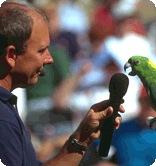Teaching patience to a Blue and Gold Macaw

I have a 20 week old Blue and Gold Macaw called Tyson who is coming along nicely with training. I work during the day and when I come home from work he runs around the cage frantically until I get him out. I have a few chores to do before I can let him out each day so I make him wait. Also on the weekends when I'm home all day he runs around frantically for the first hour if he can see me (his cage is in the kitchen/dining) Will this behaviour settle? He usually gets at least two hours a day out of his cage in the later afternoons/early night. I have taught him to fly to me on command, only problem is when is he out he flies to me constantly. Will he ever stay on his cage or play stand and play with his toys?? He has numerous toys, foraging material and sticks to chew but when he's out I am flavour of the month. This gets difficult as I need to get dinner etc. Thanks, Sue

Hello Sue,
Thanks for your questions about Tyson's behavior. My experience tells me the behavior you describe is not uncommon for birds in your situation, and these behaviors are just a few of the reasons parrots make challenging animals to share a home with. Wild macaws spend their lives with a companion by their sides. They are almost never alone in the wild. So, it makes perfect sense that a parrot in a home would do everything it can to be with you, his companion, when you come home. His behavior of running around the cage before you let him out is very likely a behavior that started out of his frustration and was reinforced by the action of you taking him out of the cage.
A behavior that is repeated has quite likely been reinforced in the past. The very act of letting Tyson out of the cage when he is pacing is likely to increase the pacing behavior. The goal now is to replace the pacing behavior with sitting on the perch behavior. If you encourage Tyson to climb up to the perch and reinforce that behavior with a treat, or even opening the door to let him out of the cage, it is likely that he will come to understand that he needs to be on the perch before you will let him out of the cage. You can also gradually extend the amount of time before you let him out of the cage so he will learn to sit on the perch a bit longer when you are home.
You asked if he will ever stay on his play stand instead of flying to you. The answer is; he will stay on his play stand when it is more reinforcing than flying to you. As yourself, "why should Tyson stay on the play stand?" What's in it for him? If being with you is more desirable to Tyson than staying on the play stand, why should he stay on the stand? Birds don't do things because they are "supposed to." They do things that the want to do. So, how do you arrange the environment so that Tyson would prefer to stay on the perch? You may be able to make it more appealing to him with toys and other enrichment items. Or, you can use treats of various types to reinforce the behavior of sitting on the perch. If he likes the treats, you can teach him that sitting on the perch a bit longer between treats will earn him a larger or more desirable reward. That variable schedule of reinforcement is similar to what I mentioned above with the pacing behavior.
Behavior is a product of consequences. When we see a behavior occur in a predictable or repeated manner, we know there is something reinforcing that behavior. We usually only need to look into the recent past to see that our actions have reinforced the unwanted behavior we are experiencing. I often hear people complain about biting, screaming, pacing and many other behaviors that they see in their birds. It is most likely that these problems are repeated because the person has reinforced the behaviors with something as simple as giving the bird some attention. Our goal should always be to replace unwanted behavior with more desirable behavior instead of trying to stop the unwanted behavior. To try and stop behavior is to try to punish the behavior, and punishment is a poor training tool when compared to positive reinforcement. We always want to stay in the positive reinforcement behavior change system to give our birds the best welfare and most enjoyable life.
I hope that helps.
Steve
Steve Martin
President, Natural Encounters, Inc.

































